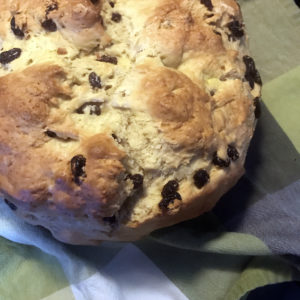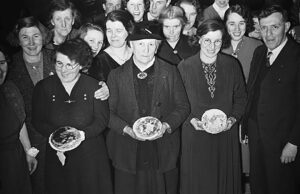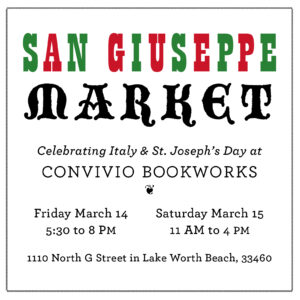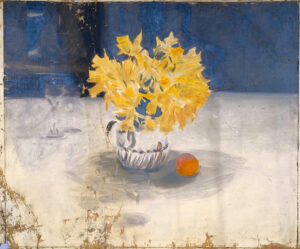For St. Patrick’s Day this year, I come bearing gifts: a quick and easy recipe for my sister’s Irish Soda Bread, and a poem to read whilst the bread is baking, or to improve upon your enjoyment of the bread later this evening with tea, toasted, with butter and perhaps a bit of Orange Saffron Preserve (which has been my favorite way to enjoy my soda bread this past week). And that’s it. Just simple, comforting stuff, which feels like just what we need these days. Nothing elaborate, nothing too celebratory, as that’s a mood I’ve just not been feeling lately. But good bread and poetry: these are things that bring me a bit of joy. Maybe they’ll help you feel better, too.
MARIETTA’S IRISH SODA BREAD
5 cups flour (plus up to an additional cup, depending on stickiness of dough)
3 tablespoons sugar
1 tablespoon baking powder
1 teaspoon salt
¾ teaspoon baking soda
6 tablespoons butter or shortening
1 cup raisins
1 tablespoon caraway seeds (optional)
2 eggs, beaten (reserve 1 tablespoon for later)
1 ½ cups milk (or buttermilk, if you have it)
If you’re using a stand mixer, place all ingredients in the mixing bowl (except for reserved tablespoon of egg) and mix. Start with 5 cups of flour, adding up to an additional cup, if necessary, if dough is sticky. Next, using dough hook, knead in bowl for a minute or so.
If, like me, you have to mix things by hand, mix flour, sugar, baking powder, salt, and baking soda in a large bowl. With a pastry blender, cut in butter or shortening until mixture resembles coarse crumbs. Stir in raisins and caraway seeds. Add beaten eggs (be sure to reserve 1 tablespoon of beaten egg for later), and then add the milk or buttermilk. Mix well. If the dough is very sticky, add up to 1 additional cup of flour, a little at a time.
Meanwhile, preheat oven to 350 F and butter a 2-quart round casserole; set aside. Flour a board and turn out dough onto it; knead for about a minute. Shape into a ball. Place the dough in the casserole, and in the center of the dough, with a sharp knife, cut a cross about 4” long and ½” deep. Brush dough with reserved egg.
Bake about 1 hour and 20 minutes or until a toothpick inserted into the bread comes out dry. Cool in casserole on wire rack for 10 minutes, then remove from the casserole and cool further on rack.
*
The Stolen Child
by William Butler Yeats
Where dips the rocky highland
Of Sleuth Wood in the lake,
There lies a leafy island
Where flapping herons wake
The drowsy water rats;
There we’ve hid our faery vats,
Full of berrys
And of reddest stolen cherries.
Come away, O human child!
To the waters and the wild
With a faery, hand in hand,
For the world’s more full of weeping than you can understand.
Where the wave of moonlight glosses
The dim gray sands with light,
Far off by furthest Rosses
We foot it all the night,
Weaving olden dances
Mingling hands and mingling glances
Till the moon has taken flight;
To and fro we leap
And chase the frothy bubbles,
While the world is full of troubles
And anxious in its sleep.
Come away, O human child!
To the waters and the wild
With a faery, hand in hand,
For the world’s more full of weeping than you can understand.
Where the wandering water gushes
From the hills above Glen-Car,
In pools among the rushes
That scarce could bathe a star,
We seek for slumbering trout
And whispering in their ears
Give them unquiet dreams;
Leaning softly out
From ferns that drop their tears
Over the young streams.
Come away, O human child!
To the waters and the wild
With a faery, hand in hand,
For the world’s more full of weeping than you can understand.
Away with us he’s going,
The solemn-eyed:
He’ll hear no more the lowing
Of the calves on the warm hillside
Or the kettle on the hob
Sing peace into his breast,
Or see the brown mice bob
Round and round the oatmeal chest.
For he comes, the human child,
To the waters and the wild
With a faery, hand in hand,
For the world’s more full of weeping than he can understand.
*
Mike Scott and the Waterboys set the poem to music late in the last century, and that is worth a listen today, as well. And so, Céad míle fáilte. A hundred thousand welcomes. St. Patrick’s Day blessings upon you and yours and upon us all.
Take note that our shop will be closed for the rest of March, but we will reopen again on the First Saturday of April, and indeed all the Saturdays of April, for our Springtide Saturdays series. Your online orders are still welcome, and we will be filling orders this week, but orders placed on March 20 or later won’t be filled until the first week of April.
We also have two in-house workshops coming up this spring! Collagraph Printmaking with instructor Kim Spivey is on Sunday April 6, and I’ll be teaching a workshop called Pure Bookbinding (these are books made without adhesive) on Sunday May 4.




